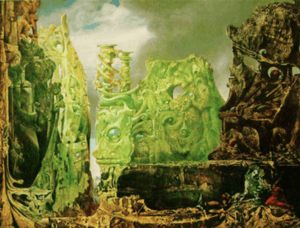The Eye of Silence
The Eye of Silence (French: L'oeil du silence), 1943–44, is a painting by German dadaist and surrealist Max Ernst.[3]
| L'oeil du silence (The Eye of Silence) | |
|---|---|
 | |
| Artist | Max Ernst |
| Year | c. 1943–44[1] |
| Medium | Oil on canvas[2] |
| Movement | Surrealism |
| Dimensions | 110 cm × 143 cm (43 in × 56 in) |
| Location | Mildred Lane Kemper Art Museum, St. Louis, Missouri |
| Owner | Washington University in St. Louis |
Description
For The Eye of Silence Max Ernst employed a technique called decalcomania to create arbitrary textures on the canvas, which he then reworked to resemble rock formations and forms of animals, plants, and architecture.[4] The imagery on the surrealist canvas has been described as a primordial-like landscape, "in which rock-hard and gelatinous formations coexist under a forbidding sky."[1] The Eye of Silence has also been described as, "part vegetation, part rock and part bejewelled baroque palace. A fusion of animal, mineral and vegetable, the painting's texture suggests bone, rag, feather and stone all at once, whilst the lake or chasm situated in its middle ground is carved out of a rock placed illogically against the sky…"[3]
Influence
A portion of the painting was used as the original cover art for the mass market paperback printing of the 1958 science fiction novel A Case of Conscience.[5] British science fiction writer J. G. Ballard was influenced by the painting, which was one of the main sources for Ballard's 1970 novel The Atrocity Exhibition.[3]
References
- Fichner-Rathus, Lois (2008). Foundations of Art and Design. Stamford, CT: Cengage Learning. p. 122. ISBN 978-1-285-45654-6.
- Brodskaïa, Nathalia (2015). Surrealism: Genesis of a Revolution. p. 122. ISBN 978-1-78310-776-6.
- Parkinson, Gavin, ed. (2015). Surrealism, Science Fiction and Comics. London: Liverpool University Press. p. 189. ISBN 978-1-78138-143-4.
- "Kemper Art Museum Art Detail". Kemper Art Museum. Retrieved 9 June 2018.
- James Pardey (14 June 2010). "Landscapes From a Dream: How the Art of David Pelham Captured the Essence of J G Ballard's Early Fiction". Ballardian. Retrieved 9 June 2018.